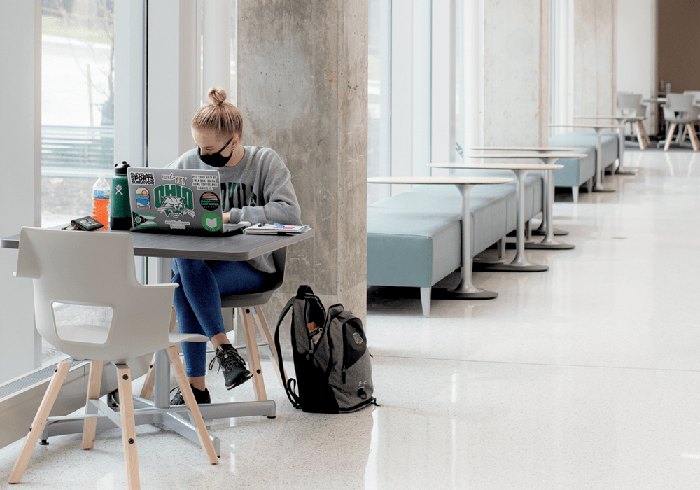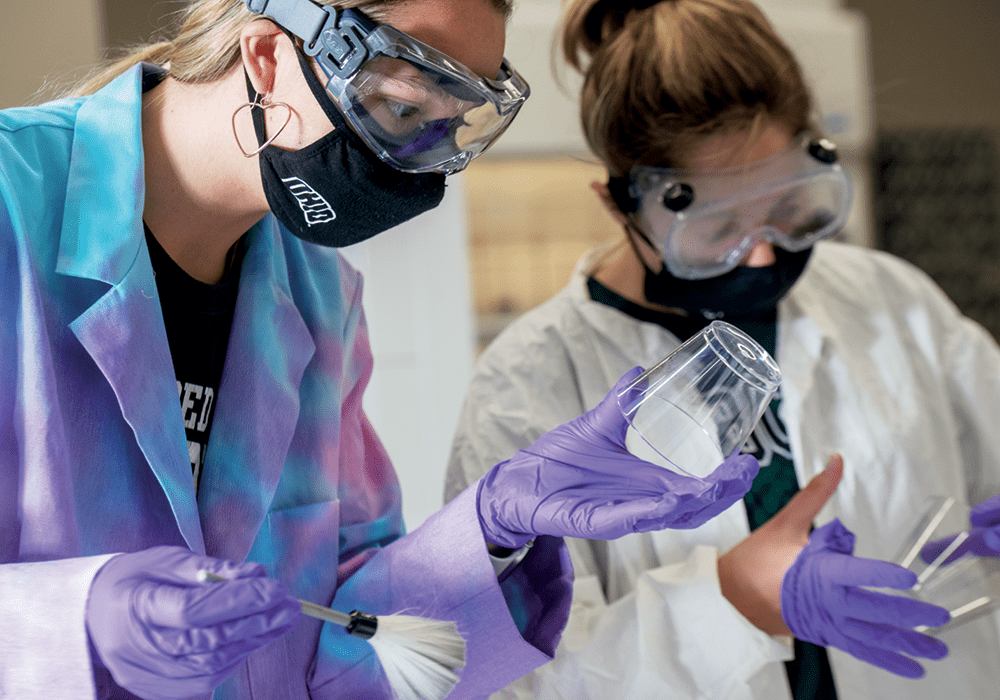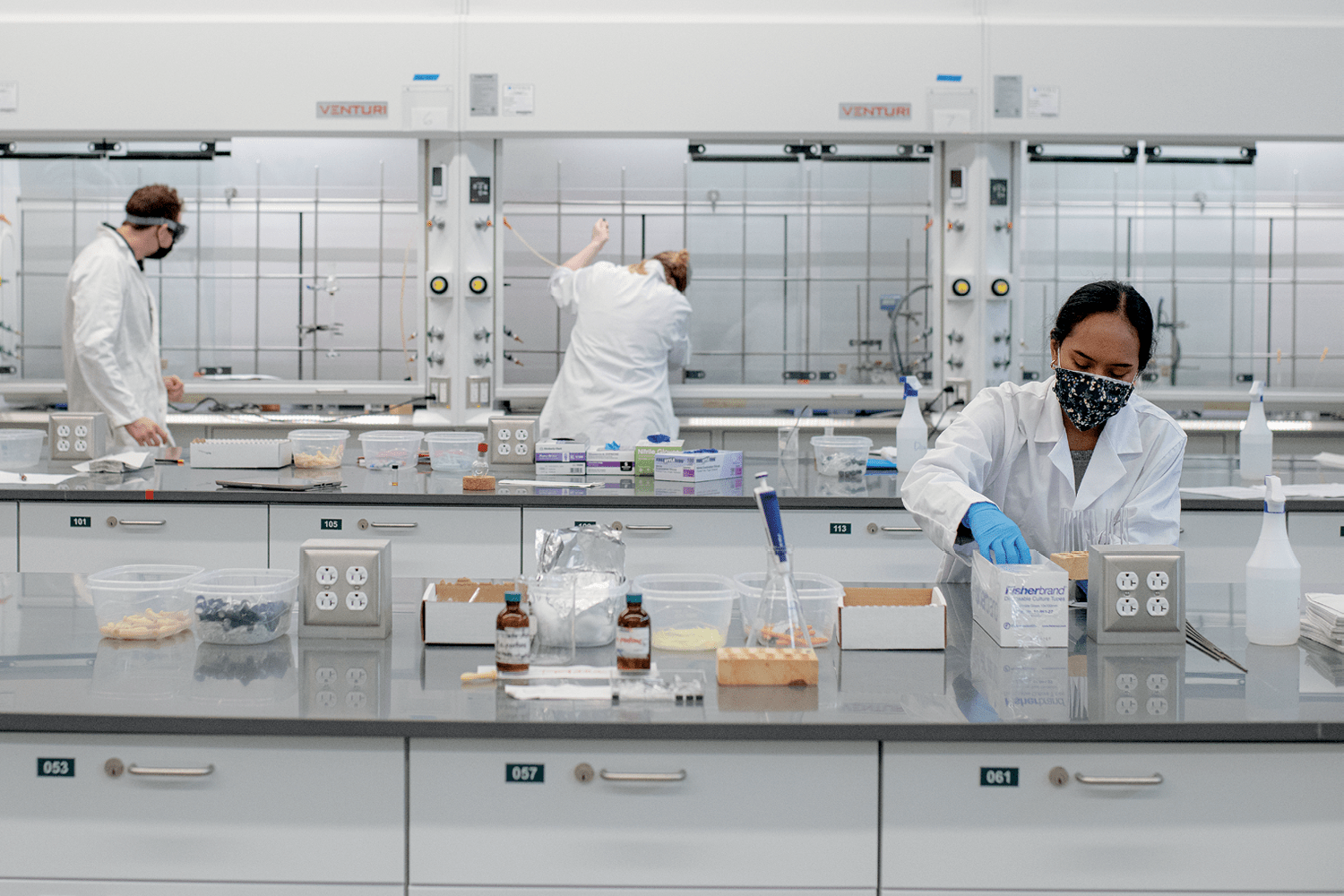
For Dr. Rebecca Barlag, BS ’98, the OHIO experience has meant the narrow halls and dimly lit basement rooms of Clippinger Laboratories. First as a student and now as a professor of instruction, she’s begun almost every school year in Clippinger 194. But spring semester brought a new tradition—in a new home.
In late 2020, the University wrapped up construction on a 34,000-square-foot Chemistry Building, converting a parking lot near Clippinger and Emeriti Park into a center for groundbreaking learning and research for future generations of scientists and scholars. Standing three stories tall, the building’s first floor features undergraduate instructional labs for organic and analytical chemistry surrounded by student collaboration space. Its upper two floors house open-concept research labs—synthetic labs on the second floor and instrumentation-based labs on the third—as well as faculty and graduate student offices.
This new epicenter for cutting-edge research will give students hands-on experience with the latest technologies, says Dr. Stephen Bergmeier, professor and chair of the Department of Chemistry and Biochemistry.
“A lot of new techniques have come out since Clippinger was built and dedicated in 1965,” he says, also noting the more advanced research projects faculty and students have taken on over the years. “The instruments tend to be more specific, so you need more of them.”
At the same time, enrollment in OHIO’s chemistry programs has exploded. Barlag, director of the Forensic Chemistry program, recalls having 35 students in her lab during her first year teaching in 2004. In 2020, she had almost 100 students.
“The labs were too crowded in Clippinger,” she says. “We desperately needed this space to accommodate and better serve our students.”

The first floor of the Chemistry Building is lined with study spaces—and windows, providing scenic campus views and putting science on display. Photo by Rich-Joseph Facun, BSVC ’01

Students lift fingerprints during a Criminalistics and Criminal Investigation for Forensic Chemists course taught by Associate Professor of Instruction Sonja Rawn, BS ’81. Photo by Ben Wirtz Siegel, BSVC ’02
The building was designed with this growth in mind—and with the goal of investing in innovative research and bringing it to the forefront of campus. The wall of windows on the building’s north side drenches labs and offices in sunlight while putting science on display. And various configurations of open, communal spaces allow for interaction, collaboration and study.
“The non-cramped nature of the building allows students that space to do their studying outside the lab, and that’s something I just love to see because it was impossible in Clippinger,” Bergmeier says.
One new space in particular had Adam Hering, BS, BA ’22, eagerly anticipating his senior-year research activities. Greeting visitors as they enter the building’s lobby, the Nuclear Magnetic Resonance (NMR) lab’s floor-to-ceiling windows bring chemical instrumentation, teaching and research out into the open.
“The lab is busy all the time,” says Hering, who spends about 10 hours a week in the NMR lab researching how smaller molecules interact with larger ones. “You get to see people working in there and see the instruments actually being used.”
Among the instrumentation housed in the NMR lab is a mass spectrometer funded by a 2020 National Science Foundation grant awarded to a group of researchers led by Bergmeier. Faculty will use the mass spectrometer to identify and characterize molecules, but that instrument and others throughout the building will also support research across the University.
“That would’ve been incredible” to see on a campus tour, Hering says of the NMR lab. “Let’s just say that I was born four years later, starting my freshman year right now. I would absolutely love what I’m looking at.”
Faculty and select students got their first taste of OHIO’s newest research facility earlier this year. Graduate students spent winter break 2020 packing up instrumentation and transferring it from Clippinger to the new building, allowing a limited number of in-person labs during spring semester in line with COVID-19 restrictions.

Step inside OHIO’s new Chemistry Building (opens in a new window)
For all the excitement, the transition is a little bittersweet for those who, like Barlag, spent untold hours in Clippinger.
“I enjoyed teaching in the room where I learned,” says Barlag. “It’s funny to say to students, ‘When I was your age, I dropped my beaker at this very lab bench and had to redo the whole experiment.’”
But Clippinger, which now connects to the Chemistry Building via a covered walkway, isn’t going anywhere. Renovation of the building’s east wing began this spring, kicking off the next phase of the Clippinger Renovation Project, which started with constructing the new Chemistry Building.
When a more modern Clippinger fully reopens in spring 2024, it will continue to house the physics, astronomy, geography and geological sciences departments, and certain chemistry classes could benefit from the updated space as well. Barlag envisions her old Clippinger basement stomping grounds as the perfect spot for her crime scene mockups, which she previously had to repeatedly set up and dismantle in her laboratory classroom.
In the meantime, students and faculty are beginning to make new memories and advancing science in the new building. Already, it feels like an integral part of the Athens Campus, Barlag says.
“It looks like Clippinger,” she says. “It looks like it belongs.”
Featured image: Students conduct experiments in the Chemistry Building’s Organic Chemistry Teaching Lab, which is equipped with 16 fume hoods, compared to only six in similar space in Clippinger Laboratories. Photo by Rich-Joseph Facun, BSVC ’01



